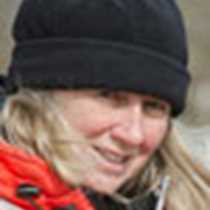Hamburgbutka, Fuglefjorden & Moffen Island
Sometimes a word rambles about in our minds transforming our perceptions of the day, tying random times and places with a common thread. Layers. We learned that layers enhance an image when trying to capture a scene. Today it seemed that everything around could be peeled away sheet by sheet to reveal a hidden mystery.
The ebony sea and tiers of charcoal clouds squeezed the mountains and glaciers of the east coast of Spitzbergen into a horizontal band. The sun selected first one river of ice and then another to spotlight with glowing brilliance. Silently the ship slipped northward accompanied by graceful fulmars and frantically flapping auks.
Sandwiched between what once was the whaling grounds of the Dutch in the north and the English in the south, a bay of miniscule scale is hidden, a diverticulum pouched into the coast of the island. On guard, a polar bear held its massive head upon its paws until rest time was over and it wandered away. Talus slopes tumbled from sharp glacially carved peaks. Like flies thousands of tiny football shaped forms swirled in tornado like fashion, emerging from these same slopes and seeming to disappear into them again. Their incessant conversations were the backdrop for the morning and if one wandered close enough, the counter-shaded forms of little auks or dovekies could be seen covering the highest stones. The ground was soft and spongy where colorful mosses and lichens carpeted the boulder-strewn ground. Waves of visitors had left their mark as well. The Hamburgers were the first to set up shop in 1642 and thus the name given to the bay, Hamburgbutka. Russian trappers, Pomars, were next and in more recent times Norwegian trappers too. One didn’t need to search too hard to see remnants of their lives, huts built on former residences and fragments of their catches. Some found this place to be their final resting spot. What beauty and peace they live in for all eternity.
Fuglebreen, a craggy glacier cascades to the sea at the northwest corner of this largest island in the archipelago. Its edges were patterned like chocolate ripple ice cream while its towering countenance wore patches of gelid blue. The sea was like a mirror decorated with diamonds at the head of the fjord as we drifted silently among the brash, listening to the sound of “bergy-seltzer.” Arctic terns creaked from tiny flat growlers and occasionally the glacier roared. Cirrus clouds, like wisps of silken threads added texture to the beautiful blue sky. Ice chilled the air that caressed the glacier’s crevassed crest and tumbled to the sea with ever increasing velocity. Outside the eddy within which we sat in our trusty Zodiacs, the katabatic winds grasped at the surface of the sea creating a chop to change our ride from that as smooth as on a newly paved road to one akin to driving on an old fashioned corduroy trail. Nearby a female walrus and her very young calf hid between smooth rocky islets, strangely distant from others of her kind.
The sun never sets and so elements are added to our experiences late into the night. Moffen Island looks like little more than an impressive sandbar with a half moon bay, its arching shore accentuated by layers of melting snow. Unimpressive as it may be from a distance, it is perfectly poised to lure a lot of blubbery forms that pile one on top of another keeping each other warm, a boy’s club for the moult. In the water other walrus tumble and tussle apparently in play. On board we watch in layers, on the bow, in the chartroom, and on the bridge as the sun goes round us in the sky.




